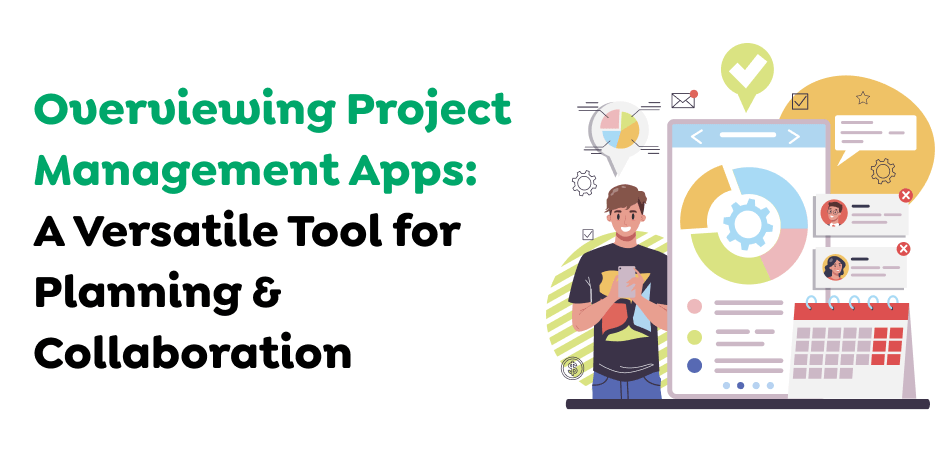Write Us
We are just a call away
[ LET’S TALK AI ]
X
Discover AI-
Powered Solutions
Get ready to explore cutting-edge AI technologies that can transform your workflow!


The time has come to choose which project management tool to use on your next venture. With the number of apps on the marketplace, it’s not surprising that you’re not sure which application is right for both you and your staff. If you’re in this situation, you don’t have to be concerned anymore. I’ve tried the free versions of 2 well-known project management tools—Trello and Asana—to ensure that you do not have to.
I’ll help you make the right choice by introducing the fundamentals of both applications’ pricing, UI/UX features, support, and security.
So, let’s get started!
Also Read – Documenting the Future: The Power of HR Document Management Software
A project management app can be mobile, web, or desktop software that allows users to plan and manage projects. It can include tools to create the project’s schedule, including milestones and assignments, assign projects to team members, establish due dates for tasks, and contact other users regarding the given (or accomplished) tasks. The app can also offer a user interface to manage workflow in the company using multiple projects simultaneously.

Apps for managing projects are like task applications. However, they differ in how they are utilized to manage large-scale projects or groups of individuals. Some popular project management applications are Asana, Wrike, Trello, and Basecamp. Examples of project management apps created:
Also Read – How to choose a Loan Document Management Software? Benefits and Key features

A good project management application will have to meet the various requirements of its users by offering efficient resource and task management, limiting the number of documents to be processed, and encouraging collaboration between team members. Furthermore, it should be scalable, customizable, and backed by a solid assistance system for bug fixing and upgrades. Here are a few key points to think about:
Intelligent Design: The user interface (UI) must be simple to navigate, visually appealing, and user-friendly. A minimalist and clear layout allows users to locate the needed information quickly and reduces their learning time for first-time users.
Task Management: A project management app’s principal goal is to organize tasks. It should facilitate the creation, tracking, and assignment of tasks that include deadline dates, priorities, statuses, and sub-tasks. This will ensure that the users are in control and stay focused.
Collaboration: This app needs to aid team collaboration by offering tools for communication such as live chat, comments, push notifications of files, and file sharing. A streamlined queueing system for tasks and easy-to-follow progress charts improve collaboration and efficiency.
Customization: Each team functions differently, which requires the flexibility of customizable features. A good project management application will allow users to build customized workflows, create custom fields, and customize the interface to their needs.
Scalability: The application should be able to scale to meet the demands of expanding team members and their projects. This requires increasing capacity for more users, storage, tasks, and users, in addition to providing easy integration with other apps.
Safety and Compliance: Keeping sensitive data and ensuring compliance with the relevant regulations for data security are crucial. This requires solid encryption, secure storage of data, and monitoring for possible security breaches.
Accessible on a Variety of Devices: An excellent project management application should be accessible across various devices, from desktop computers to smartphones. Users can check information and track project progress while on the move, increasing flexibility and efficiency.
Also Read – Custom Hotel Management Software Features: Identifying Core Financial Information

Asana and Trello are two of the most popular software for managing projects, each offering different user preferences and styles of management. Let’s look at their most essential characteristics to understand their layout and function better:
Spaces for Work: Asana lets users create multiple workspaces for various groups and projects. Each group has its own workspace customized to meet its particular requirements and preferences, helping to facilitate collaboration between teams whenever necessary.
Task Hierarchy: The tasks within Asana can be subdivided into tasks, making it simple to manage large projects with many dependencies. The app users can set priority, due dates, and status to their tasks, as well as add files and comments to provide more context.
Multiple Views: Asana allows project representation on the board, list, timeline, calendar, and views. This flexibility lets users pick the most appropriate representation for their project, which helps with better organization and planning.
Progress Tracking: With built-in progression tracking features, such as graphs and charts, Asana allows users to track project progress and spot bottlenecks quickly. This facilitates data-based decision-making and improves project management overall.
Third-Party Integrations: Asana integrates with a wide variety of third-party applications, which allows users to simplify their workflows by consolidating data and tools. The most commonly used integrations comprise Slack, Google Drive, Dropbox, Salesforce, and many others.
Kanban-style Boards: Trello utilizes a Kanban-style board layout, where projects are separated into lists representing various phases of the process. The users create cards for their tasks that are easily moved across lists, providing an image of their progress.
Card Features: Cards from Trello may be personalized with labels, deadlines, attachments, checklists, and even comments. Users can assign assignments to team members and establish priority levels, making sure that everyone is aware and focused on their tasks.
Templates: Trello provides a variety of templates to suit different industries and usage scenarios. Templates help users set up lists and boards using predefined best practices, streamlining the setup process.
Power-Ups: The power-ups feature is one of Trello’s widget-like extensions that boost its functionality by adding additional features such as voting, calendar, and integration with other applications like Google Drive, Slack, and more.
Notifications: Trello offers real-time notification of task changes, ensuring that all team members know the most recent changes and the progress made. Desktop, email, and mobile notifications can be customized to suit the user’s preferences.
Also Read – Navigating the Impact of IoT & Cloud Computing on Modern Technology
Let’s examine the advantages of Trello and Asana so that you can make the best choice for your business and personal needs.

Trello offers various pricing options. The base plan cost to develop a mobile app in Saudi Arabia is just $6 a month and includes features such as unlimited Kanban boards, cards, lists of members, checklists, and attachments. For those who require more advanced features, such as priority support, a simple export of data, and custom backgrounds and stickers, premium plans and custom plans are offered.
Asana’s pricing starts at $13.49 per month for each member when billed monthly. The Starter plan comes with important features such as task lists, board views, calendars, and assignments. There are plans for those who require more advanced features for more sophisticated requirements. There are advanced, enterprise, and enterprise + plans, which provide additional features, such as advanced search and report customized fields and provisioning and de-provisioning of users.
Trello’s pricing is less expensive, particularly for startups or smaller teams on a budget. However, Asana’s more expensive pricing offers a wider range of features. This makes it ideal for larger companies or those with more complicated projects and requirements.
Verdict: Trello leads in terms of pricing because of its lower prices. However, the ultimate option will depend on your individual needs and budget.
The Trello free version is an excellent start for individuals and small groups. It comes with unlimited boards, cards, and lists, which enables you to manage your tasks efficiently. However, it limits the number of teams using Kanban boards to 10 and limits specific integrations and power-ups.
However, Asana offers a free plan with essential features like projects, tasks, and collaborations for at least ten team members. The plan does not limit the amount you can make and includes basic dashboards that provide overviews of projects.
In comparing the free plans, Asana has an advantage due to its absence of limitations in the number of tasks that can be worked on and the capability to collaborate with a broader group of colleagues. Additionally, adding basic dashboards could be an essential aspect for teams that require an overview of their work.
Verdict: Asana offers more excellent value for the free package.
Also Read – Unmasking the Cost of Event App Magic: A Deep Dive into Factors and Figures
The Design of Trello is attractive and user-friendly, thanks to its platform being based upon its Kanban system. It provides a simple card-based interface, where each task is represented by cards that can be moved around various columns or lists representing multiple project stages. This makes it simple for users to see your work’s flow and track your progress.
Asana, on the other hand, was built to handle more complex tasks and workflows. It also has a sleek and intuitive interface and more advanced features, such as timeline views, calendar integration, and more detailed options for managing tasks. It offers multiple ways to organize your functions: as an outline, on a Kanban board, on a calendar, or as a timeline.
In terms of design and function, Asana offers more flexibility and advanced features, making it more suitable for managing complex projects. However, Trello’s simplicity and design may be more appealing to those seeking a simple tool that focuses on the visual management of tasks.
Verdict: Asana offers more versatility in design and function, while Trello is a winner in simplicity and user-friendliness.
Trello is based on the ease of drag-and-drop card layouts, making it an ideal choice for people who love the Kanban style. It’s easy to use and lets you visualize your workflow quickly. Furthermore, Trello’s power-ups allow integration with other applications and enhance functionality.
Asana is powerful project management software for large and complex teams. It offers multiple task perspectives, including the list view Kanban Board, Calendar, or timeline. Additionally, advanced features such as custom fields, task dependencies, and milestone tracking are included in Asana’s software.
When comparing both project management platforms, Asana seems to provide an extensive collection of tools that make it the better choice when it comes to managing large tasks or processes. But Trello holds its ground because of its simplicity and user-friendliness, especially for those who prefer visual task management.
Verdict: Asana is the more substantial choice of project management tools for people needing detailed and feature-rich management software.
Trello depicts tasks as cards that you drag and drop onto various lists or stages. Each card can have labels, checklists, due date attachments, comments, and due dates to make it easier to manage tasks. It’s an attractive system that allows you to keep track of the tasks that need to be completed and when.
Asana, however, provides a more precise method for managing tasks. Tasks can be broken into subtasks, each with an assigned assignee and a due date. You can also add descriptions and attachments, write comments, or make an assignment plan if necessary.
Although Trello and Asana provide solid task management features, Trello is known for its user-friendly Design and ease of use. It’s simple to use and offers a high degree of customization, which makes it an excellent option for teams that appreciate visual workflows.
Verdict: Trello leads by offering a user-friendly and flexible system for managing tasks.
Also Read – What Does It Cost to Develop a Construction Management Software Like Procore?
Trello is an online project management system where you can collaborate with your associates on projects. It allows you to assign tasks, make comments, and attach documents directly to your Trello cards. The visual design of Kanban boards will enable you to track the team’s progress and the projects’ progress.
However, Asana offers more advanced collaboration tools. Like Trello, you can assign subtasks and tasks, add comments, and even attach files. However, Asana can also help you keep track of task dependencies, establish priorities, and design specific task areas.
Comparing the two, Asana provides a more extensive collaboration platform. It’s ideal for teams required to manage large projects that involve a lot of moving components. But if you’re searching for a simple tool that can keep everybody on the same track, then Trello’s simplicity may be the key aspect.
Verdict: Asana offers more advanced collaboration capabilities, but Trello has the most simple and user-friendly interface.
Trello excels due to its extensive variety of integrations. It can seamlessly integrate with various apps, including well-known tools such as Google, Evernote, HubSpot, Facebook, and Outlook. In particular, the Google Calendar integration enables syncing Trello cards and boards to your calendar, easing the tracking of important dates and deadlines.
Asana is also an excellent integration tool. It’s easy to connect to numerous apps, including Slack, Google Drive, and Dropbox. The Google Calendar integration lets you see your Asana deadlines and tasks directly on your calendar.
Both Trello and Asana provide powerful integration capabilities, which makes them great choices based on your particular requirements. Trello shines with its numerous applications that can be integrated, while Asana’s simplified Google Calendar integration might be more appealing for those who are heavily dependent on Google’s collection of apps.
Verdict: Trello vs Asana for integrations? There’s a tie between the two!
Trello provides a variety of customer support options, including a complete information base, email service, and forums for community members. These tools are very useful in identifying issues and learning to utilize the platform. However, the time to respond is not the same, and there may be some limitations on direct, immediate assistance.
However, Asana provides similar support options, such as a comprehensive help center, email support, and forums for community members. In addition, Asana is known for its faster customer support, particularly for premium users, with the most direct and personal assistance options.
If you’re looking at client support, Asana tends to stand apart due to its responsive and personalized service. This is particularly beneficial for teams that require immediate assistance or have complicated questions. The amount of support Asana provides, especially on premium accounts, could be a major benefit in ensuring the smooth management of projects.
Verdict: Asana edges ahead with its faster and more comprehensive assistance system, which provides customer service that is particularly useful for teams that require rapid and customized help.
Trello’s mobile application is known for its simplicity and user-friendly Design. It is similar to what you can get from a desktop and allows you to manage lists, boards, and cards. It is easy to use and effective for controlling your tasks in the field; however, it isn’t equipped with some of the advanced features available in its desktop counterpart.
However, Asana’s mobile application provides a fuller experience than its desktop counterpart. It has a range of features, such as task management and reviewing project timelines. The clean and easy-to-use layout makes navigation and tracking tasks simple, even if you’re working from home.
Regarding mobile apps, Asana stands out for providing users with a more comprehensive experience. Its application is built on the same functions as the desktop version, and it makes it easy to manage tasks and projects regardless of location.
Verdict: Trello vs. Asana for mobile apps? Asana is the superior choice due to its wide-ranging capabilities and easy-to-use interface, which make managing your projects on the go easy.
Also Read – Unleashing the Power of AI: Transforming Software Development with Machine Learning
Trello provides a range of different AI project management and automation options. For example, its Strategy-AI Power-Up lets you prioritize according to strategic considerations on your boards and lists. Additionally, the Trello Butler tool lets users design rules, buttons, and commands to automate virtually every action, allowing you to simplify tasks and workflows more effectively.
Asana is also a powerful capability for workflow automation. It allows you to set up rules that automate repetitive tasks and decrease the time spent on manual tasks. From assigning tasks to updating custom fields, Asana’s automated system can streamline your workflow. When comparing the two platforms, Trello’s Butler is the clear winner due to its capability to automate many tasks and its effortless integration into the system’s structure.
Verdict: Trello takes the lead in AI as well as automation.
Trello provides various Power-Ups to help with time tracking. For instance, the Time Tracking & Reporting Power-Up allows you to record your reports and work, which is helpful for invoicing and billing clients. The Time Tracker from TimeCamp Power-Up also lets you record time and create time reports for any credit card at no cost.
However, Asana has built-in time-tracking capabilities. You can record time manually spent on specific tasks or utilize the timer to keep track of your work automatically. Additionally, Asana integrates with several time-tracking software, such as Harvest, which allows for more precise time management and reports.
If you consider both, Trello provides more versatility by offering a variety of time-tracking power-ups. This lets you select the tool that best meets your needs and gives Trello an edge in this area.
Verdict: Trello is the more efficient choice for tracking time. It is an integrated, user-friendly system that seamlessly integrates into your workflow for managing tasks.
Trello provides essential task management features via its card system and board. It allows you to see who’s doing what and monitor the progress of your tasks. However, it does not have advanced tools to track the workload of all team members, which can be a problem in managing teams with larger numbers of employees.
Asana excels at managing workloads by utilizing its own features. It gives a complete overview of each team member’s work and current workload, which is easily understood. Features such as task assignments, capacity tracking, task assignments, and workload distribution are integrated into the software, providing an effective solution to balance teams’ workloads.
Regarding managing workloads, Asana stands out for its broad capabilities. Its capacity to offer a complete and clear depiction of team workloads makes it an excellent option for teams that must effectively manage and balance their workloads.
Verdict: Should you choose Trello or Asana to manage workloads? Asana is the best choice, with advanced features to help you manage and manage team workloads effectively.
Also Read – How Much Does it Cost to Create a Mobile App in Dubai in 2024?
A project management application typically requires around $37,500 as quoted by the mobile app development company in Saudi Arabia. The total cost could be as low as $25,000 and even $50,000. An app for managing projects that have limited features (also called an MVP) is cheaper than an app with all the functionality it is designed to provide. For instance, here are a few previous pricing quotes for project management apps.

As your app’s users increase and the market changes and changes, you must concentrate on constant improvement and updates to keep your application up-to-date and relevant. Furthermore, a monetization plan is essential to recovering your investment and generating income. Take a look at the following strategies for future enhancements and the monetization process:
Continually improve your app, adding new features or enhancements in reaction to user feedback and market trends. Analyze your competitors and the industries to determine areas where your app could be more valuable or distinguish its value.
Ensure your app yields the latest security best practices and industry standards to stay safe and up-to-date. This will protect your users’ data and help maintain their confidence and retention.
Concentrate on improving your regular users’ experience (UX) to ensure that your app is more user-friendly, efficient, and user-friendly. Utilize user feedback and analytics to pinpoint improvement areas and refine your app’s design and function.
Think about integrating your app for project management with popular third-party tools like Slack, Google Drive, and other productivity tools. This will increase your app’s collaborative capabilities and make it more appealing to potential users.
Create a monetization plan for your project management application to generate income. You might want to consider combining the following strategies given by the mobile app development company in Dubai:
Also Read – Understanding the Challenges & Costs of Hiring iOS App Developers in the Middle East

Asana and Trello can be excellent software for managing projects based on your organization’s needs. You should consider Asana for those who want to manage projects with more than two people, especially when managing a smaller group. It is recommended that Trello be used by those who require a visual management tool, and you don’t have to split subtasks between teams often. Both have a free version, allowing you to try both for yourself and see what you like.
Need help choosing the right tool for your business? Techugo, a leading app development company, can provide expert guidance. Our team can assess your specific needs and recommend the best project management solution for your organization. Get in touch with us to know more.
Write Us
sales@techugo.comOr fill this form